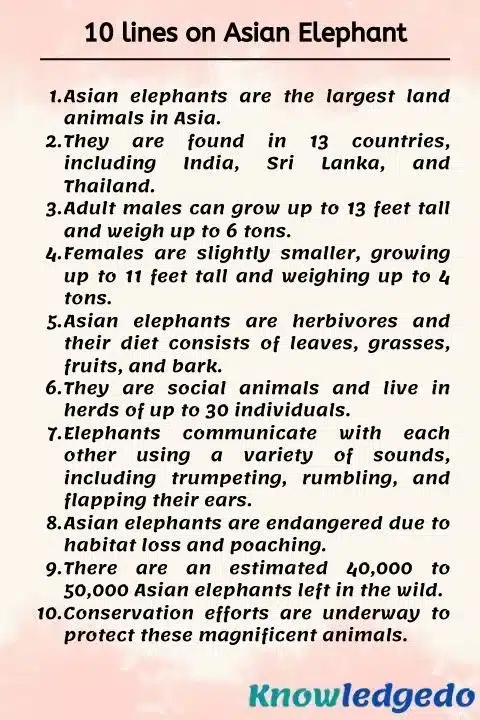Today, we are sharing 10 lines on Asian Elephant in English. This article can help students who are looking for information about 10 lines on Asian Elephant. These lines are straightforward and easy to remember. The level of difficulty is moderate, making it accessible for any student to write on this topic.
This article is generally useful for class 1,class 2,class 3,class 4,class 5,class 6,class 7,class 8,class 9,class 10,class 11,class 12
10 lines on Asian Elephant
1) Asian elephants are the largest land animals in Asia.
2) They are found in 13 countries, including India, Sri Lanka, and Thailand.
3) Adult males can grow up to 13 feet tall and weigh up to 6 tons.
4) Females are slightly smaller, growing up to 11 feet tall and weighing up to 4 tons.
5) Asian elephants are herbivores and their diet consists of leaves, grasses, fruits, and bark.
6) They are social animals and live in herds of up to 30 individuals.
7) Elephants communicate with each other using a variety of sounds, including trumpeting, rumbling, and flapping their ears.
8) Asian elephants are endangered due to habitat loss and poaching.
9) There are an estimated 40,000 to 50,000 Asian elephants left in the wild.
10) Conservation efforts are underway to protect these magnificent animals.

5 lines on Asian Elephant
1) The Asian elephant is the largest land animal in Asia.
2) They are found in 13 countries, including India, Sri Lanka, and Thailand.
3) Asian elephants are herbivores and their diet consists of leaves, grasses, fruits, and bark.
4) They are social animals and live in herds of up to 30 individuals.
5) Asian elephants are endangered due to habitat loss and poaching.
FAQ
Answer: The main difference between Asian and African elephants is their size. Asian elephants are smaller than African elephants, with adult males growing up to 13 feet tall and weighing up to 6 tons. African elephants, on the other hand, can grow up to 13 feet tall and weigh up to 13 tons.
Another difference is the shape of their ears. Asian elephants have smaller, rounded ears, while African elephants have larger, fan-shaped ears.
Finally, Asian elephants have one tusk, while African elephants have two tusks.
Answer: There are an estimated 40,000 to 50,000 Asian elephants left in the wild. This number is declining due to habitat loss and poaching.
Answer: The main threats to Asian elephants are habitat loss and poaching. Habitat loss occurs when forests are cleared for human development, such as agriculture and mining. Poaching occurs when elephants are killed for their ivory tusks.
Other threats to Asian elephants include conflict with humans, disease, and climate change.
Answer: There are a number of conservation efforts underway to protect Asian elephants. These efforts include:
>Creating protected areas for elephants to live in.
>Reducing human-elephant conflict.
>Educating people about the importance of elephants.
>Working to reduce poaching.
Answer: Conserving Asian elephants has a number of benefits, including:
>Protecting a keystone species that plays an important role in the ecosystem.
>Providing jobs and income for local communities.
>Boosting tourism.
>Raising awareness of conservation issues.
Answer: There are a number of things you can do to help Asian elephants, including:
>Support conservation organizations that are working to protect elephants.
>Educate yourself and others about the threats facing elephants.
>Choose products that are not made from ivory.
>Avoid supporting businesses that are involved in poaching or the illegal ivory trade.
Answer: There are a number of places where you can see Asian elephants in the wild, including:
> India
> Sri Lanka
> Thailand
> Nepal
> Bhutan
> Myanmar
> Cambodia
> Laos
> Vietnam
> Indonesia
